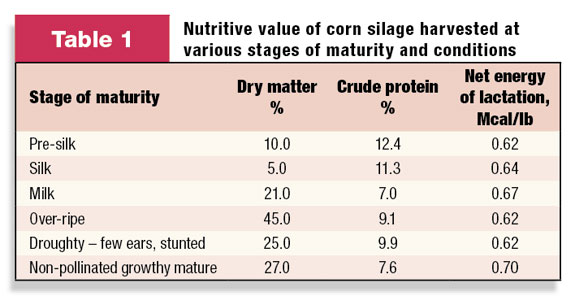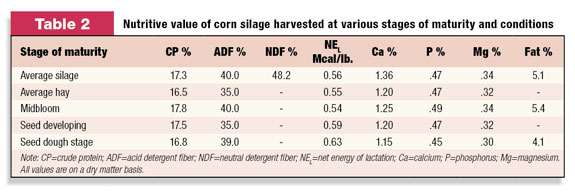Adverse weather conditions like drought present the dairy producer with some major challenges. The largest problem is having enough forage available to feed all animal groups. The second significant problem is forage quality. The obvious questions to ask during drought situations are:
- Should hay or other forage be purchased?
- Should forage intakes be kept atthe minimum level recommended?
- Should more high-fiber feeds be used?
The economics of the situation, including effects on cash flow and interest charges, should receive top priority. The palatability of the items being evaluated and their suitability for use in the feeding system should also be considered.
In addition to the aforementioned items, there are other risk factors that occur during a drought that can have a substantial impact on animal performance. Nitrates, prussic acid and other poisons can jeopardize both production and health of animals. Poisonous plants and weeds can be an issue and should not be overlooked.
Nutritive value of drought-stricken corn silage
Drought-stricken corn can make nutritious silage. Absence of ears does not imply that corn silage lacks fermentable energy. Forage portions should contain reasonably high levels of soluble sugars. As corn approaches maturity, the energy level and dry matter yield increase. It is recommended to allow corn to develop as fully as possible, even if ears and grain are lacking.

There are wide variations in the nutritive content of drought-stressed corn silage (Table 1). It may have an energy value 85 to 100 percent of normal corn silage, or it may be quite different. Very young corn prior to tasseling may contain as much as 14 to 16 percent crude protein. A standard forage analysis is highly recommended, along with testing for levels of nitrates.
If it becomes necessary to harvest very short immature corn (up to and including silking stage), it is not prudent to add a non-protein nitrogen (NPN) source like ammonia or urea at the time of ensiling. Preferably, the dry matter content of droughty silage should be in the range of 30 to 40 percent to make satisfactory silage. If the corn did not set ears and is green, or if the ears are all brown and the stalk is green, the moisture content may be too high, but hot, dry weather can cause rapid moisture drops. Careful observations of moisture changes are needed to determine the best time to harvest.
Another weather-related complication is frost on drought-stressed corn. When frost occurs on immature plants, it will appear drier than unfrosted corn of the same moisture content. Even though leaves may brown off along the edges and dry rapidly after a few sunny days, the green stalk and ears do not. The crop will continue to accumulate dry matter and should be left in the field until it reaches the appropriate moisture content.
Immature plants that are killed will likely contain too much moisture for immediate ensiling. These plants will dry slowly and dry matter losses will increase as the dead plants drop their leaves. The best option is to leave the crop in the field until it reaches the appropriate dry matter level, unless losses appear too high or harvesting losses will increase dramatically.
Pricing drought-damaged corn silage is similar to normal corn silage, with a few adjustments. The best method is to sell on the basis of tons of dry matter. For example, corn silage at 27 percent dry matter is worth 77 percent as much as corn silage at 35 percent dry matter (27 divided by 35 = 0.77) when priced on an as-fed basis. Thus moisture will be taken into account if pricing is done on a dry matter basis. Several samples of silage should be taken during ensiling to ensure the dry matter determination is representative.
Generally, drought-damaged corn may be lower in energy and dry matter, but similar or higher than usual in protein level. Prices can be adjusted accordingly. For example, if the total digestible nutrients is 62 percent instead of the usual 70 percent, the value of the corn silage would be adjusted downward by 89 percent (62 divided by 70) from the usual corn silage price.
Nutritive value of drought soybeans as forage
Drought or immature soybean plants can be used as a forage crop. Plants should be allowed to mature as much as possible before harvesting. Some pod or bean development enhances feeding value of plants harvested either as hay or silage. Soybean forage is high in calcium and should be avoided as the major forage source for dry cows.
If the plants are going to be ensiled, it is recommended to do so before plant moisture drops below 60 to 65 percent. If possible, mix soybeans with other forages, preferably during ensiling to enhance palatability. If plants are high in moisture and lack pod or bean development, it is suggested to add 100 to 200 pounds of a ground grain per ton when direct-cutting rather than wilting to 60 to 65 percent moisture.
The stems of soybean plants are not very palatable, and animals will sort them out if given the opportunity. Chopping soybean hay and feeding it in a total mixed ration will help prevent sorting.
If soybean forage contains substantial amounts of developed beans, you may need to reduce the amount of other fats and oils in the ration for lactating cows based on the analyzed fat content of the soybeans. It may be difficult to dry down pods for hay if beans are too well-developed. Cows can be pastured on soybeans and if cows are removed before all stems are eaten, there may be regrowth.

As with any forage, soybeans should be analyzed for their nutrient content. Table 2 lists the expected nutrient content of soybean forage. It is also advisable to check the label of any herbicide used for possible restrictions on feeding soybean forage to livestock.
Forage poisoning problems
Nitrate toxicity
Drought conditions may increase nitrate levels in forages to the point of possible toxicity. Drought-stricken fields of corn, sorghum and sudangrass are most apt to contain harmful levels of nitrate, particularly those that have been heavily fertilized with manure or nitrogen. Numerous weeds such as pigweed and lambsquarter are nitrate accumulators. Any forage that is suspected of containing high levels of nitrates should not be grazed or green-chopped.
Although nitrate levels in drought-stricken corn may be high, ensiling usually reduces more than half the nitrates to ammonia, which can be utilized by the rumen bacteria. For this reason, nitrate toxicity rarely occurs when feeding ensiled drought corn. However, if drought damage was extreme and high levels of nitrogen were applied to the soil, a nitrate test on the silage should be conducted.
Rate of nitrate intake is the most critical factor influencing possible toxicity. This is affected by rate of forage dry matter intake in a given period of time and its nitrate content. Forages containing under 1,000 parts per million (ppm) nitrate-nitrogen (NO3-N) on a dry matter basis may be fed free-choice or with no restriction on meal size. That’s provided the total level of NO3-N in the total ration, including water, is kept at a safe or low-risk level. Stored forages containing higher levels generally require limiting meal size to avoid elevated methemoglobin levels in the blood and other toxic effects.
A single meal refers to the amount of stored forage dry matter consumed during one episode of eating that may range from a few minutes to two hours. High-nitrate forage should not be fed again for two to three hours after completion of the previous feeding. Observe animals closely for symptoms of toxicity two hours following the start of a meal consisting of a suspected or high- nitrate forage (over 1,000 to 1,300 ppm NO3-N).
The color of mucous membranes in the vagina, mouth, or eyes will turn from pink to a grayish-brown at a methemoglobin content of 20 percent or higher. This is the earliest sign of a possible toxicity occurring with slight to acute symptoms. Acute symptoms include rapid breathing, incoordination or staggering, and signs of suffocation. Freshly drawn blood from animals with nitrate poisoning may be chocolate brown in color.
Prussic acid poisoning
Sorghum, sudangrass and their crosses, and Johnsongrass may contain dangerous levels of prussic acid. Wild cherry and some other plants also may contain prussic acid. Risk of prussic acid poisoning may be reduced if sorghum-sudangrass is at least 30 inches high before harvesting and Piper sudangrass is at least 18 inches high.
Frosted material should not be used unless it is completely killed or dried and should be cut no earlier than four to seven days after a killing frost. If material is stunted by frost, delay using it until after a killing frost, or ensile the material. Ensiling does not always alleviate the danger of prussic acid poisoning. It generally does, however, after about four weeks of ensiling. This is especially true if harvest is delayed until after a second or killing frost occurs.
Symptoms of toxicity are similar to nitrate toxicity. Affected animals suffer because the oxygen-carrying capacity of their blood is reduced. Freshly drawn blood from animals suffering from prussic acid toxicity may turn brilliant or cherry red upon exposure to air. PD
—Excerpts from Penn State University Extension bulletin





